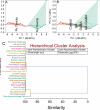Mitigating effect of γ-aminobutyric acid and gibberellic acid on tomato plant cultivated in Pb-polluted soil
- PMID: 40216907
- PMCID: PMC11992259
- DOI: 10.1038/s41598-025-96450-4
Mitigating effect of γ-aminobutyric acid and gibberellic acid on tomato plant cultivated in Pb-polluted soil
Abstract
Soil heavy metal pollution poses a significant environmental risk to human health and plant growth. Gibberellic acid (GA) and γ-aminobutyric acid (GABA) are effective methods for resolving this issue. GA regulates growth mechanisms such as seed germination, flowering, and stem elongation. Plants use GABA, a signaling molecule, to control physiological processes, growth, and responses to stress. This substance plays a crucial role in the interactions between hormones and plant defense, as evidenced by its effects on photosynthesis, food absorption, and stomatal behavior. The study aimed to determine how GABA and GA amendments affected tomato plants under no toxicity and Pb toxicity. The study included four treatments (0, GA, GABA, and GA + GABA) in four replications following a completely randomized design. Notably, the GA + GABA treatment led to considerable enhancements in fresh weight (88.98%), dry weight (68.28%), shoot length (39.98%), and root length (115.43%) compared to the control under Pb toxicity. Moreover, GA + GABA treatment significantly increased tomato chlorophyll a (161.72%), chlorophyll b (93.33%), and total chlorophyll content (112.45%) under Pb stress toxicity, confirming the effectiveness of GA + GABA treatment. In conclusion, GA + GABA is recommended as the best amendment to mitigate Pb stress in tomato plants. Our findings have broader implications for GA + GABA application, offering a potential technology to enhance sustainable crop production by improving plant growth and yield in Pb-contaminated soils. More investigations are suggested at field levels under different agroclimates on different crops for the declaration of GA + GABA as the best amendment for alleviating different heavy metal pollutions and sustainable agriculture productions.
Keywords: Gibberellic acid; Growth attributes; Lead toxicity; Plant health; Restoration; γ-Aminobutyric acid.
© 2025. The Author(s).
Conflict of interest statement
Declarations. Competing interests: The authors declare no competing interests. Ethics approval and consent to participate: We all declare that manuscript reporting studies do not involve any human participants, human data, or human tissue. So, it is not applicable. Study protocol must comply with relevant institutional, National, and international guidelines and legislation: Our experiment follows the with relevant institutional, national, and international guidelines and legislation.
Figures








Similar articles
-
Impact of gibberellic acid GA3, quantum dot biochar, and rhizosphere bacteria on fenugreek plant growth and stress responses under lead stress.Sci Rep. 2024 Nov 28;14(1):29612. doi: 10.1038/s41598-024-81072-z. Sci Rep. 2024. PMID: 39609486 Free PMC article.
-
Enhancing wheat growth under chromium toxicity using gibberellic acid and microbial inoculants as modulating agents.Sci Rep. 2025 Mar 11;15(1):8356. doi: 10.1038/s41598-025-92828-6. Sci Rep. 2025. PMID: 40069275 Free PMC article.
-
Physiological mechanisms of heavy metal detoxification in tomato plants mediated by endophytic fungi under nickel and cadmium stress.Plant Physiol Biochem. 2025 Apr;221:109589. doi: 10.1016/j.plaphy.2025.109589. Epub 2025 Feb 3. Plant Physiol Biochem. 2025. PMID: 39913979
-
Combined effect of gallic acid and zinc ferrite nanoparticles on wheat growth and yield under salinity stress.Sci Rep. 2024 Jun 4;14(1):12854. doi: 10.1038/s41598-024-63175-9. Sci Rep. 2024. PMID: 38834735 Free PMC article.
-
Unveiling the potential of A. fabrum and γ-aminobutyric acid for mitigation of nickel toxicity in fenugreek.Sci Rep. 2024 May 14;14(1):11042. doi: 10.1038/s41598-024-61894-7. Sci Rep. 2024. PMID: 38745058 Free PMC article.
Cited by
-
Local Fungi Promote Plant Growth by Positively Affecting Rhizosphere Metabolites to Drive Beneficial Microbial Assembly.Microorganisms. 2025 Jul 26;13(8):1752. doi: 10.3390/microorganisms13081752. Microorganisms. 2025. PMID: 40871256 Free PMC article.
References
-
- Kohli, S. K. et al. Current scenario of Pb toxicity in plants: unraveling plethora of physiological responses. In Reviews of Environmental Contamination and Toxicology 153–197. (Springer, 2019). 10.1007/398_2019_25 - PubMed
-
- Ahmed, N. et al. Mitigation of lead (Pb) toxicity in rice cultivated with either ground water or wastewater by application of acidified carbon. J. Environ. Manag.307, 114521 (2022). - PubMed
-
- Tokarz, K., Piwowarczyk, B. & Makowski, W. Mechanisms involved in photosynthetic apparatus protection against lead toxicity. In Lead in Plants and the Environment (eds Gupta, D., Chatterjee, S. & Walther, C.) 117–128 (Springer, 2020). 10.1007/978-3-030-21638-2_7
-
- Fiaz, K. et al. Drought impact on Pb/Cd toxicity remediated by Biochar in brassica Campestris. J. Soil. Sci. Plant. Nutr.14, 845–854 (2014).
-
- Inayat, H., Saif, H., Danish, S., Obaid, S. A. & Ansari, M. J. Improving growth of Solanum melongena L. exposed to lead (Pb) stress using gibberellic acid in combination with Agrobacterium fabrum. Plant. Stress13, 100503 (2024).
MeSH terms
Substances
LinkOut - more resources
Full Text Sources

